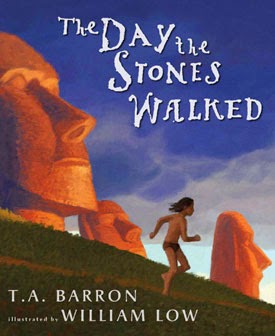Chilean Tales: Pictures Books from Chile and Thereabouts
 Mariana and the Merchild
Mariana and the MerchildA Folk Tale From Chile
by Caroline Pitcher
illustrated by Jackie Morris
published by William B. Eerdmans Publishing Company (2000)
A kindly but lonely Mariana, living in a ramshackle hut by the sea, goes about her daily motions with an ache in her heart. She tries to befriend the local kids, who seem a bit wary of her.
One fine morning-after-the-storm, she finds a merbaby washed up ashore. She immediately takes a liking to her and brings her up with all the love she can pour into this relationship. The merbaby's mother, a gentle Sea Spirit who is nothing short of Amazonian, allows Mariana to raise the child for a while.
Mariana laughs and plays with the child, ever so happy, and grateful for all the love. The wary children notice this softer side of her and start overcoming their reservations. However, she knows she has to surrender the child soon and not matter how hard she prepares for that day, she is not ready when the day comes.
Finally, bereft of the merbaby, Mariana gets inconsolable. But now, the kids who had been wary of her earlier, approach her and try to comfort her.
The illustrations are wonderful, even though the text was a bit clunky for a read aloud. The merging of the two worlds - the physical human one and the magical, mythical one - is seamless in the pictures, as if Nature, in its limitless capacity, has conjured up this realm where all this is possible.
[view more images at jackiemorris.co.uk]
[image source: Eerdmans Books]
The Day the Stones Walked
by T.A. Barron
illustrated by William Low
published by Philomel (2007)
We've all pondered on the symbolism and significance of the moai, the Stone Statues of Easter Island. While there is no conclusive evidence of its purpose and relevance, it is nevertheless intriguing to speculate on how they might have come into existence.
The author unfolds a moving story that searches the spiritual realm for a deeper understanding of our connection to this world and its people.
Young Pico finds it odd that his father prefers carving huge monoliths with faces larger than life. He wonders why his father does not hunt octopus or build boats like others. The land that once supported them has been gradually stripped. The complex culture that thrived in the island was failing.
When a tsunami approaches and he runs to warn his father, Pico finds himself submerged by the huge wave. As he struggles to get a breath, he notices a giant stone statue moving, reaching out, helping him surface and live. He remembers the legend about the giant stone figures: In times of trouble, they will rise and walk.
[image source: http://tabarron.com/books/picture-books/day-stones-walked/]
Ghost Hands
A Story Inspired by Patagonia's Cave of the Hands
by T.A. Barron
illustrated by William Low
published by Philomel (2011)
When the author visited the Patagonian Cave of Hands, he knew there was a story to be told. Even though it has remained a mystery, all the handprints in the cave, plus a lone footprint, painted by the native Tehuelche tribe of Patagonia has probably inspired many stories.
"The hands in the wondrous cave seems almost alive-- waving to us across centuries of time. I would love to meet those artists, to shake their living hands. And I would also love to ask them one question: Why in the world did you paint that foot?"
The author goes on to tell us his version of why there is a lone footprint. Auki, a young boy, is impatient, he can't wait to go hunting. His father says he is not ready. But the youth defies his father and sets out at dawn one fine day on his own anyway. He climbs up a cliff and waits. Sure enough a puma comes. He falls down, twists his ankle, crawls down, having escaped puma's claws.
At the bottom, by the icy river, he finds a cave. A cave full of handprints painted in bright colors. He meets the old man who does the painting. When the old man is not forthcoming with the reason he paints those hands, Auki decides to limp back to his home, tail between his legs so-to-speak, chiding himself for not being able to face up to the puma.
Suddenly he hears the old man scream and so he rushes back to the cave where the puma is about ready to pounce. He slides in between the puma and the old man and ends up kicking the puma in the face, thus chasing it away for now. His foot in agony, he faints. The old man carries him safely home.
When Auki is visited by the old man again, weeks later, Auki demonstrates that he has learnt patience by not asking those burning questions he had about those hands in the cave. The old man explains it in his own way stating that hands have protected his people always and this is a way to honor them. And then, he says he is going to paint someone very brave today, but not his hand. This time it will be the foot that saved the old man - Auki's foot!
[image source: amazon.com]
Labels: ages 6-9, books, chile, cluster, fiction, folktale, picture book




0 Comments:
Post a Comment
<< Home